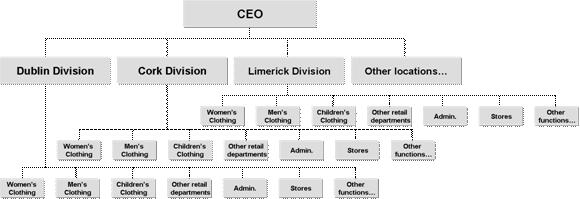A functional organisation structure is where a business is divided into separate departments such as operations and purchasing along with separate support departments such as administration, accounting, marketing and sales. The managers of each department are only responsible for their part in the process of ensuring the provision and sale of a product or service. For example, a purchasing manager is responsible for ensuring the raw materials or products purchased are of good quality and meet the required specifications for the best possible price. Marketing and sales managers are responsible for total sales revenue and the costs associated with selling. The revenues from the marketing department and the costs from the other departments (cost centres) are combined only at managing director or CEO level. This would occur where a company produces a similar type of product or service in the same location. The following is an example of a functional organisation structure relating to the retail sector

A divisionalised or decentralised organisation structure occurs where the organisation is broken into divisions in accordance with the products or services offered. Each divisional manager is responsible for all the operations relating to their particular product or service. Thus the autonomy experienced at CEO level in a functional organisation is similar to that experienced by a divisional head in a decentralised organisation structure. An example would be a large hotel chain where the general manager heading up each hotel has decision-making responsibility over costs and revenues and an input into investment decisions. Decentralisation is the delegation of decision-making responsibility and is a necessary response to the increasing complexity of the business environment that organisations face and the increasing size of many organisations. Today it is impossible for one person to make all the decisions involved in the operation of even a small company, hence senior managers delegate decision-making responsibility to subordinates. The following is an example of a divisionalised organization structure relating to the retail sector

A cost centre is where the manager of such a centre or division is responsible for the costs associated with that centre and hence the main focus is cost minimisation. This level of decentralisation occurs normally in functional organisation types. From a management accounting perspective where performance measurement is crucial, key performance appraisal measures used would be cost variances from budget as well as the trends in cost ratios such as labour as a percentage of total costs.
A profit centre is where the manager of such a centre or division has responsibility for both revenue and costs for the assets assigned to the division. Thus performance is measured in terms of the difference between the revenues and costs that relate to a profit centre. A profit centre is like a separate company with its own profit and loss account and the manager’s decisions relate to the revenue and costs that make up the divisions profit statement. From a management accounting perspective, key performance appraisal measures used would be cost and revenue variances to budget, as well as the preparation of key profit ratios such as gross profit percentage, operating profit percentage and expenses to sales percentages. Divisional profit statements are commonly used in profit centres and mainly distinguish between costs that are controlled by the division and costs that are controlled by head-office.
An investment centre is where the manager has responsibility for not just the revenues and costs relating to the centre, but also the assets that generate these costs and revenues and the investment decisions relating to disposal and acquisition of assets. For managers of investment centres, the main performance measures used will be based on return on investment and breaking that down into its two component parts namely operating profit margin and capital employed turnover (asset turnover). Two measures of divisional performance most commonly used are; return on investment (ROI) and residual income.
The managers of the Athlone division of ‘Looking Good plc’, a retail chain dealing in cosmetic products, has decision-making authority over selling price and has responsibility for controlling costs. Decisions on fixed asset acquisitions and disposals are made at head-office. Is the Athlone division a profit centre, a cost centre or an investment centre?
The Athlone division would be would be considered a profit centre as management have decision-making authority over revenues and costs. It does not have this authority over fixed asset acquisitions and disposals and thus would not be considered an investment centre.